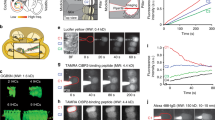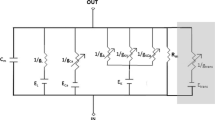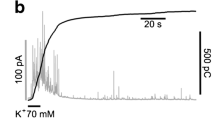Abstract
Sensory hair cells, located at the cochlea, convert sound into a depolarizing stimulus that, as a response to an increase in the intracellular Ca\(^{2+}\) concentration, triggers the release of glutamate. Experimental observations have shown that depending on their location in the inner ear, sensory hair cells respond differently to sounds of different frequencies. The origin of this behavior is still a matter of debate but, given the importance of the dynamics of intracellular Ca\(^{2+}\) for the exocytotic response, it has been hypothesized that the availability of endogenous Ca\(^{2+}\) buffers at the active zone, along with the size of the readily releasable pool of glutamate vesicles, could be associated to the frequency-dependent tuning of the exocytotic response. Here, we implemented a computational model of the active zone of a sensory hair cell with the main objective of evaluating the effects of the endogenous Ca\(^{2+}\) buffers and the readily releasable pool on the fast exocytosis of glutamate.
Access this chapter
Tax calculation will be finalised at checkout
Purchases are for personal use only
Similar content being viewed by others
References
Gil, A., Segura, J., Pertusa, J., Soria, B.: Monte Carlo simulation of 3-D buffered Ca\(^{2+}\) diffusions in neuroendocrine cells. Biophys J. 78, 13–33 (2000)
Segura, J., Gil, A., Soria, B.: Modeling study of exocytosis in neuroendocrine cells: influence of the geometrical parameters. Biophys. J. 79, 1771–1786 (2000)
Johnson, S., Olt, J., Cho, S., Gersdorff, H., Marcotti, W.: The coupling between Ca\(^{2+}\) channels and the exocytotic Ca\(^{2+}\) sensor at hair cell ribbon synapses varies tonotopically along the mature cochlea. J. Neurosci. 37, 2471–2484 (2017)
Jessica, A.: Soto Bear, Modelado estocástico de la secreción en células ciliadas internas del trayecto auditivo. Universidad Autónoma Metropolitana, Azcapotzalco, Mexico City (2019)
Zampini, V., et al.: Elementary properties of CaV1. 3 Ca2+ channels expressed in mouse cochlear inner hair cells. J. Physiol. 588, 187–199 (2010)
Brandt, A., Khimich, D., Moser, T.: Few CaV1. 3 channels regulate the exocytosis of a synaptic vesicle at the hair cell ribbon synapse. J. Neurosci. 25, 11577–11585 (2005)
Wagner, E., Shin, J.: Mechanisms of hair cell damage and repair. Trends Neurosci. 42, 414–424 (2019)
Patel, S.H., Salvi, J.D., Ó Maoiléidigh, D., Hudspeth. A.J.: Frequency-selective exocytosis by ribbon synapses of hair cells in the bullfrog’s amphibian papilla. J Neurosci. 32, 13433–13438 (2012)
Pangršič, T., et al.: EF-hand protein Ca2+ buffers regulate Ca2+ influx and exocytosis in sensory hair cells. Proc. Natl. Acad. Sci. U. S. A. 112, E1028-37 (2015)
Kujawa, S.G., Liberman, M.C.: Synaptopathy in the noise-exposed and aging cochlea: primary neural degeneration in acquired sensorineural hearing loss. Hear. Res. 330(Part B), 191–199 (2015)
Altoé, A., Pulkki, V., Verhulst, S.: Model-based estimation of the frequency tuning of the inner-hair-cell stereocilia from neural tuning curves. J. Acoust. Soc. Am. 141, 4438–4451 (2017)
Lopez-Poveda, E., Eustaquio-Martín, A.: A biophysical model of the inner hair cell: the contribution of potassium currents to peripheral auditory compression. J. Assoc. Res. Otolaryngol. 7, 218–235 (2006)
Nakamura, Y., Reva, M., DiGregorio, D.: Variations in Ca2+ influx can alter chelator-based estimates of Ca2+ channel-synaptic vesicle coupling distance. J. Neurosci. 38, 3971–3987 (2018)
Nakamura, Y.: EGTA can inhibit vesicular release in the nanodomain of single Ca2+ channels. Front. Synaptic Neurosci. 11, 26 (2019)
Author information
Authors and Affiliations
Corresponding author
Editor information
Editors and Affiliations
Rights and permissions
Copyright information
© 2023 The Author(s), under exclusive license to Springer Nature Switzerland AG
About this paper
Cite this paper
Valverde-Alonzo, C.A., Félix-Martínez, G.J., González-Velez, V., Gil, A. (2023). Role of Endogenous Ca\(^{2+}\) Buffering and the Readily Releasable Pool on Fast Secretion in Auditory Inner Hair Cells. In: Trujillo-Romero, C.J., et al. XLV Mexican Conference on Biomedical Engineering. CNIB 2022. IFMBE Proceedings, vol 86. Springer, Cham. https://doi.org/10.1007/978-3-031-18256-3_23
Download citation
DOI: https://doi.org/10.1007/978-3-031-18256-3_23
Published:
Publisher Name: Springer, Cham
Print ISBN: 978-3-031-18255-6
Online ISBN: 978-3-031-18256-3
eBook Packages: EngineeringEngineering (R0)




